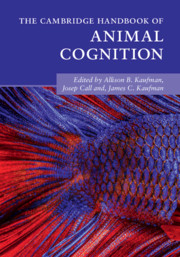Book contents
- The Cambridge Handbook of Animal Cognition
- The Cambridge Handbook of Animal Cognition
- Copyright page
- Dedication
- Contents
- Figures, Tables, and Boxes
- Contributors
- Acknowledgments
- Introduction
- Part I Communication and Language
- Part II Memory and Recall
- 6 Memory and Recall Overview
- 7 A Fish Memory Tale
- 8 Memory in Hummingbirds
- 9 Event Memory in Rats
- 10 Primate Recall Memory
- Part III Social Cognition
- Part IV Social Learning and Teaching
- Part V Numerical and Quantitative Abilities
- Part VI Innovation and Problem-Solving
- Index
- References
8 - Memory in Hummingbirds
from Part II - Memory and Recall
Published online by Cambridge University Press: 01 July 2021
- The Cambridge Handbook of Animal Cognition
- The Cambridge Handbook of Animal Cognition
- Copyright page
- Dedication
- Contents
- Figures, Tables, and Boxes
- Contributors
- Acknowledgments
- Introduction
- Part I Communication and Language
- Part II Memory and Recall
- 6 Memory and Recall Overview
- 7 A Fish Memory Tale
- 8 Memory in Hummingbirds
- 9 Event Memory in Rats
- 10 Primate Recall Memory
- Part III Social Cognition
- Part IV Social Learning and Teaching
- Part V Numerical and Quantitative Abilities
- Part VI Innovation and Problem-Solving
- Index
- References
Summary
Hummingbirds are faced with a challenging memory task every day. In order to keep a positive energy balance, these birds need to remember which flowers they have visited and which ones they have not. The properties of flowers provide hummingbirds with different types of information about colour, shape, space, and time to guide how they forage. Here we discuss how researchers have adapted established laboratory paradigms for use in the field to understand how hummingbirds use this information. We discuss why hummingbirds have turned out to be a suitable model to study cognition in the wild, the main findings that have established how to study memory in wild animals of a project expanding to three decades.
Keywords
- Type
- Chapter
- Information
- The Cambridge Handbook of Animal Cognition , pp. 174 - 189Publisher: Cambridge University PressPrint publication year: 2021
References
- 1
- Cited by



